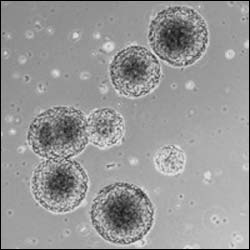Insulin-producing cells from brain cursors

Insulin-producing neurospheres. (Photo: Seung Kim et al.)
In a paper in this month’s freely-available online global health journal PLoS Medicine Seung Kim and colleagues from Stanford University suggest that one way of producing insulin-secreting pancreatic islet cells for future possible treatment of type I diabetes is to look beyond immature pancreatic cells and embryonic stem cells to other early cell types. Kim and colleagues took cells derived from brain which usually mature into neural cells, and exposed them to a series of signals that are known to drive pancreatic islet development. They were able to produce clusters of insulin-producing cells that responded to glucose out of the body.
When the cells were then transplanted into immunocompromised mice the cells could also be stimulated by glucose to produce human insulin. Future work will need to establish the long-term stability and safety of these cells and to work out how to scale up such a process to produce the much larger numbers of cells that would be needed for human treatment. However, the authors conclude that this technique “could serve as the basis for developing replacement islets from a wide range of human stem cells, including neural stem cells and ES cells.”
Media Contact
All latest news from the category: Life Sciences and Chemistry
Articles and reports from the Life Sciences and chemistry area deal with applied and basic research into modern biology, chemistry and human medicine.
Valuable information can be found on a range of life sciences fields including bacteriology, biochemistry, bionics, bioinformatics, biophysics, biotechnology, genetics, geobotany, human biology, marine biology, microbiology, molecular biology, cellular biology, zoology, bioinorganic chemistry, microchemistry and environmental chemistry.
Newest articles

Trotting robots reveal emergence of animal gait transitions
A four-legged robot trained with machine learning by EPFL researchers has learned to avoid falls by spontaneously switching between walking, trotting, and pronking – a milestone for roboticists as well…

Innovation promises to prevent power pole-top fires
Engineers in Australia have found a new way to make power-pole insulators resistant to fire and electrical sparking, promising to prevent dangerous pole-top fires and reduce blackouts. Pole-top fires pose…

Possible alternative to antibiotics produced by bacteria
Antibacterial substance from staphylococci discovered with new mechanism of action against natural competitors. Many bacteria produce substances to gain an advantage over competitors in their highly competitive natural environment. Researchers…





















